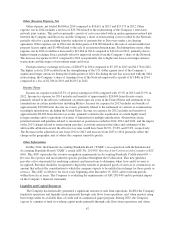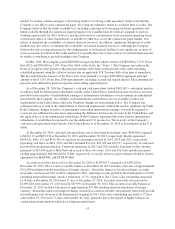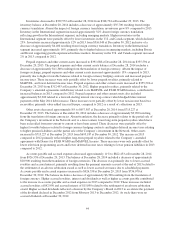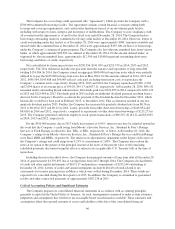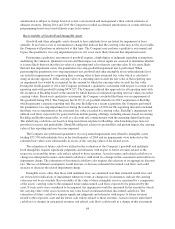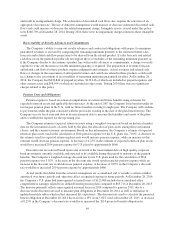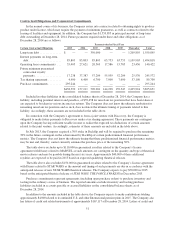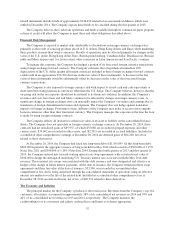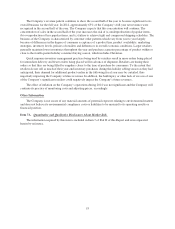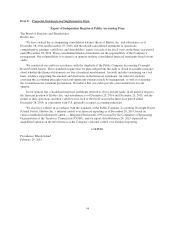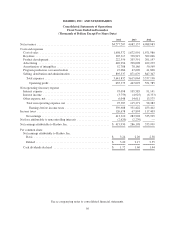Hasbro 2014 Annual Report Download - page 64
Download and view the complete annual report
Please find page 64 of the 2014 Hasbro annual report below. You can navigate through the pages in the report by either clicking on the pages listed below, or by using the keyword search tool below to find specific information within the annual report.
approximately $12,175. Pension plan assets are valued on the basis of their fair market value on the measurement
date. These changes in the fair market value of plan assets impact the amount of future pension expense due to
amortization of the unrecognized actuarial losses or gains.
Income Taxes
The Company’s annual income tax rate is based on its income, statutory tax rates, changes in prior tax
positions and tax planning opportunities available in the various jurisdictions in which it operates. Significant
judgment and estimates are required to determine the Company’s annual tax rate and in evaluating its tax
positions. Despite the Company’s belief that its tax return positions are fully supportable, these positions are
subject to challenge and estimated liabilities are established in the event that these positions are challenged and
the Company is not successful in defending these challenges. These estimated liabilities are adjusted, as well as
the related interest, in light of changing facts and circumstances, such as the progress of a tax audit.
An estimated effective income tax rate is applied to the Company’s interim results. In the event there is a
significant unusual or extraordinary item recognized in the Company’s interim results, the tax attributable to that
item is separately calculated and recorded at the time. In addition, changes in judgment regarding likely
outcomes related to tax positions taken in a prior fiscal year, or tax costs or benefits from a resolution of such
positions would be recorded entirely in the interim period the judgment changes or resolution occurs. During
2014 and 2013, the Company recorded a net benefit of approximately $20,000 and $30,000, respectively,
associated with discrete tax events, primarily related to the completion of U.S. and Mexico tax examinations as
well as certain other U.S. and foreign prior period tax adjustments. During 2014 the Company paid
approximately $65,000 to settle tax assessments and years subject to audit from 2000 through 2013 in Mexico.
The Company incurred additional tax expense in 2014 of $6,910 related to this settlement.
In certain cases, tax law requires items to be included in the Company’s income tax returns at a different
time than when these items are recognized on the consolidated financial statements or at a different amount than
that which is recognized on the consolidated financial statements. Some of these differences are permanent, such
as expenses that are not deductible on the Company’s tax returns, while other differences are temporary and will
reverse over time, such as depreciation expense. These differences that will reverse over time are recorded as
deferred tax assets and liabilities on the consolidated balance sheets. Deferred tax assets represent deductions that
have been reflected in the consolidated financial statements but have not yet been reflected in the Company’s
income tax returns. Valuation allowances are established against deferred tax assets to the extent that it is
determined that the Company will have insufficient future taxable income, including capital gains, to fully realize
the future deductions or capital losses. Deferred tax liabilities represent expenses recognized on the Company’s
income tax return that have not yet been recognized in the Company’s consolidated financial statements or
income recognized in the consolidated financial statements that has not yet been recognized in the Company’s
income tax return. Deferred income taxes have not been provided on most of the undistributed earnings of
international subsidiaries as most of such earnings are indefinitely reinvested by the Company. In the event the
Company determines that such earnings will not be indefinitely reinvested, it would be required to accrue for any
additional income taxes representing the difference between the tax rates in the United States and the applicable
tax of the international subsidiaries. At December 28, 2014, the difference between the tax rates in the United
States and the applicable tax of the international subsidiaries on cumulative undistributed earnings was
approximately $513,000.
50




